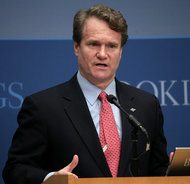Correction Appended
 Kevork Djansezian/Associated PressBank of America bought Countrywide in 2008.
Kevork Djansezian/Associated PressBank of America bought Countrywide in 2008.
9:00 p.m. | Updated
Bank of America is continuing a large-scale retreat from its costly expansion into the home mortgage market, a shift that concentrates more power in the hands of its biggest rivals and leaves fewer options for some home buyers.
The bank, which already has sharply scaled back in making mortgages, on Monday sold off about 20 percent of its loan servicing business as part of its agreement to pay the housing finance giant Fannie Mae more than $11 billion to settle a bitter dispute over bad mortgages.
The payment resolves claims that Bank of America made bad mortgages before the financial crisis that home buyers had a hard time repaying, and then sold those troubled mortgages to the government. When borrowers defaulted — sometimes within months of taking out a mortgage — the taxpayer-supported Fannie Mae suffered immense losses.
Related Links
 Documents: News release from Bank of America
Documents: News release from Bank of America Documents: News release on foreclosure abuse settlement
Documents: News release on foreclosure abuse settlement- Banks to Pay $8.5 Billion to Speed Up Housing Relief (Jan. 7, 2012)
- Graphic: Backing Away From Home Loans
Less competition in the mortgage market could hurt consumers, potentially raising the costs of borrowing. The problems at Bank of America have cut down its mortgage ambitions; it accounts for 4 percent of the nation’s mortgage market, a slide from just over 20 percent in 2009, ceding market dominance to Wells Fargo and JPMorgan Chase.
“This is part of a broader consolidation of banks and that is something that we should all be very, very concerned about,” said Ira Rheingold, executive director of the National Association of Consumer Advocates. “Anything that leads to less competition can only be bad for consumers.”
 Win McNamee/Getty ImagesBrian Moynihan, chief of Bank of America.
Win McNamee/Getty ImagesBrian Moynihan, chief of Bank of America.
Also Monday, Bank of America and nine other lenders agreed to an $8.5 billion settlement with banking regulators to resolve claims of foreclosure abuses that included flawed paperwork and bungled loan modifications. While the two agreements were separate, they represented one of the biggest single days for government settlements with United States banks, totaling $20.15 billion, and illustrated the extent of the banks’ role in the excesses of the credit boom, from the making of loans to the seizure of homes.
While costly, analysts said, the settlements may reduce legal uncertainties for lenders and spur more banks to compete for home loan business.
In its agreement with Fannie Mae, which the government controls, Bank of America will pay the agency about $3.6 billion to compensate for faulty mortgages and $6.75 billion to buy back mortgages that could have resulted in future losses for the government. The bank also agreed to sell to other firms the right to collect payments on $306 billion worth of home loans.
“Bank of America is sending a clear message that the bank only wants to be the mortgage lender to a select, small group of people,” said Glenn Schorr, an analyst with Nomura.
Bank of America has been battered by a steady stream of losses after its 2008 purchase of Countrywide Financial, the subprime lender that has come to symbolize the reckless lending practices of the real estate bubble. Before Monday, the $4 billion Countrywide acquisition had cost Bank of America more than $40 billion in losses on real estate, legal costs and settlements. Most of the loans covered in the Fannie Mae settlement were issued by Countrywide from 2000 to 2008.
“These agreements are a significant step in resolving our remaining legacy mortgage issues, further streamlining and simplifying the company and reducing expenses over time,” the bank’s chief executive, Brian T. Moynihan, said in a statement.
Bank of America said it expected the settlement to depress its fourth-quarter earnings by $2.5 billion. Its shares, which doubled in 2012, on Monday essentially closed flat at just over $12.
While the settlement will resolve all of the lender’s disputes with Fannie Mae, which weighed on the bank, Bank of America still faces billions of dollars in claims from investors and federal prosecutors.
While the mortgage market is consolidating in the hands of a small number of banks, the housing market is showing signs of recovery. The Federal Reserve has spent hundreds of billions of dollars to stimulate the economy, driving down interest rates on 30-year mortgages to 3.34 percent. In the last year, this has helped lift house prices from their lows and prompted a boom in refinancings. At the same time, though, even borrowers with strong credit complain about onerous checks and backlogs in the application process. This suggests banks are still struggling to efficiently follow the higher standards introduced since the financial crisis.
Nearly all mortgages that banks make right now are transferred to the government, which guarantees that they will be repaid.
Most analysts agree that mortgage rates would be lower if banks were competing more vigorously for business. Because the settlements could ease legal uncertainties surrounding mortgage lending, a wider array of banks might be encouraged to lend more, eating into the market share of giants like Wells Fargo.
“Every one of these puts a little more distance between the banks and their subprime problems,” said Guy Cecala, publisher of Inside Mortgage Finance, an industry publication.
Wells Fargo made 30 percent of all new mortgages in the first nine months of 2012, far ahead of the second-place JPMorgan, which accounted for 10 percent of the market, according to figures from Inside Mortgage Finance. In 2007, Wells Fargo originated 11 percent of new mortgages.
“The markets are actually more competitive than ever,” said Vickee Adams, a spokeswoman for Wells Fargo Home Mortgage. She says smaller banks are making gains in some of the nation’s biggest urban markets.
Some mortgage analysts said the settlements did not provide the level of legal clarity that the banks crave. “We haven’t done enough listening to the banks,” said Christopher J. Mayer, a professor at Columbia Business School. For instance, he says, the banks need clearer rules on when they have to take back loans they have sold to government housing entities.
But a big problem may be that many banks are too poorly run to compete, a situation that may not quickly change even with greater legal clarity. Bank of America’s servicing operations have struggled for several years.
“It may be that Bank of America decided that it wasn’t good enough at servicing,” said Thomas Lawler, a former chief economist of Fannie Mae and founder of Lawler Economic and Housing Consulting, a housing analysis firm.
The bank is looking to refocus beyond the mortgage business. To that end, Bank of America agreed to offload the servicing rights on two million loans with an outstanding principal of $306 billion. Those rights were scooped up by specialty mortgage servicing firms, including Nationstar Mortgage Holdings and the Newcastle Investment Corporation, which collect payments from borrowers.
Jerry Dubrowski, a spokesman for Bank of America, said, “The strategy is simple: to focus on our core retail customers, to be able to provide an entire array of products and services to them, in which mortgage is an integral product, but not the only product.”
Correction: January 8, 2013
An earlier version of this article omitted one element of the settlement between Bank of America and Fannie Mae, and summaries of the article in some sections of nytimes.com consequently understated the total amount of the two mortgage-related settlements announced Monday. It is more than $20 billion, not $18.5 billion.
Article source: http://dealbook.nytimes.com/2013/01/07/bank-of-america-to-pay-10-billion-in-settlement-with-fannie-mae/?partner=rss&emc=rss
Speak Your Mind
You must be logged in to post a comment.